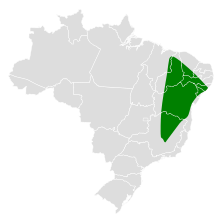| Caatinga cacholote | |
|---|---|

| |
| In Paraíba, Brazil | |
| Conservation status | |
 Least Concern (IUCN 3.1) | |
| Scientific classification | |
| Domain: | Eukaryota |
| Kingdom: | Animalia |
| Phylum: | Chordata |
| Class: | Aves |
| Order: | Passeriformes |
| Family: | Furnariidae |
| Genus: | Pseudoseisura |
| Species: | P. cristata |
| Binomial name | |
| Pseudoseisura cristata (Spix, 1824) | |

| |
The Caatinga cacholote (Pseudoseisura cristata) is a species of bird in the Furnariinae subfamily of the ovenbird family Furnariidae. It is endemic to Brazil.
Taxonomy and systematics
The Caatinga cacholote is monotypic. However, what is now the grey-crested cacholote (P. unirufa) was previously considered a subspecies of it. The two-subspecies P. cristata was then called the rufous cacholote. The two taxa were split following the data in a paper published in 2000. Confusingly, and contrary to the suggestion of the 2000 paper's authors, the South American Classification Committee of the American Ornithological Society and the Clements taxonomy call P. unirufa the rufous cacholote.
Description
The Caatinga cacholote is 25 to 26 cm (9.8 to 10 in) long. It is a large, crested, furnariid with a long bill. The sexes have the same plumage. Adults are mostly bright reddish-rufous that is somewhat paler on their underparts. Their flight feathers have fuscous tips and the ends of the tail feathers lack barbs. Their iris is yellow. Juveniles have a shorter crest than adults, with some dusky streaks or bars on the face and underparts and a bluish gray iris.
Distribution and habitat
The Caatinga cacholote is found in eastern Brazil in an area bounded roughly by eastern Maranhão, Paraíba, and central Minas Gerais. It inhabits the woodlands and scrub of the Caatinga biome and also tropical deciduous forest. Away from areas of dense human population it is common around dwellings. In elevation it ranges from 50 to 500 m (160 to 1,600 ft).
Behavior
Movement
The Caatinga cacholote is a year-round resident throughout its range.
Feeding
The Caatinga cacholote feeds on arthropods and plant material. It usually forages in pairs and usually on the ground, where it probes and digs for its prey.
Breeding
The Caatinga cacholote's breeding season has not been defined. Though the species is believed to be mostly monogamous, several observations of breeding pairs included up to four apparent adults, all of whom provisioned nestlings. It is not known if the helpers are related or not to the primary pair. Its nest is a mass of thorny sticks that is typically twice as long as it is wide, placed in a tree fork or on a utility pole. An entrance tunnel near its top leads to an inner chamber lined with pieces of bark and snake skin. One nest in Ceará incorporated a large number of anthropogenic materials including razor blades, a fork, plastic items and fragments, paper, and barbed wire. The clutch size, incubation period, time to fledging, and further details of parental care are not known.
|
Songs and calls Listen to Caatinga cacholote on xeno-canto |
Vocalization
The Caatinga cacholote typically sings in duet. One bird, thought to be the male, "gives a long series of well-spaced, very loud, piercing 'tjew' notes". The presumed female replies with "a series of 15–35 well-spaced buzzy 'zjeep' notes". The species' call is "a single 'chuk' ".
Status
The IUCN has assessed the Caatinga cacholote as being of Least Concern. It has large range and an unknown population size that is believed to be increasing. No immediate threats have been identified. It is considered common "especially where caatinga severely degraded or overgrazed" and has "extended its range locally where forest has been cleared". In addition, it occurs in several protected areas.
References
- ^ BirdLife International (2016). "Caatinga cacholote Pseudoseisura cristata". IUCN Red List of Threatened Species. 2016: e.T22733859A95067314. doi:10.2305/IUCN.UK.2016-3.RLTS.T22733859A95067314.en. Retrieved 18 November 2023.
- ^ Gill, Frank; Donsker, David; Rasmussen, Pamela, eds. (July 2023). "Ovenbirds, woodcreepers". IOC World Bird List. v 13.2. Retrieved July 31, 2023.
- ^ Zimmer, K., and Whittaker, A. (2000). The Rufous Cacholote (Furnariidae: Pseudoseisura) is two species. Condor. 102(2): 409–422
- Remsen, J. V., Jr., J. I. Areta, E. Bonaccorso, S. Claramunt, G. Del-Rio, A. Jaramillo, D. F. Lane, M. B. Robbins, F. G. Stiles, and K. J. Zimmer. Version 28 September 2023. A classification of the bird species of South America. American Ornithological Society. https://www.museum.lsu.edu/~Remsen/SACCBaseline.htm retrieved October 20, 2023
- Clements, J. F., P.C. Rasmussen, T. S. Schulenberg, M. J. Iliff, T. A. Fredericks, J. A. Gerbracht, D. Lepage, A. Spencer, S. M. Billerman, B. L. Sullivan, and C. L. Wood. 2023. The eBird/Clements checklist of birds of the world: v2023. Downloaded from https://www.birds.cornell.edu/clementschecklist/download/ retrieved October 28, 2023
- ^ Remsen, Jr., J. V. (2020). Caatinga Cacholote (Pseudoseisura cristata), version 1.0. In Birds of the World (J. del Hoyo, A. Elliott, J. Sargatal, D. A. Christie, and E. de Juana, Editors). Cornell Lab of Ornithology, Ithaca, NY, USA. https://doi.org/10.2173/bow.caacac1.01 retrieved November 18, 2023
- ^ van Perlo, Ber (2009). A Field Guide to the Birds of Brazil. New York: Oxford University Press. p. 222. ISBN 978-0-19-530155-7.
- Gonalalves Diotaiuti, L.; Mendonca Bezerra, C.; José Soares, C.; Mariana Costa, L.; Eremelinda Barbosa, S. (2018) “Description of an Amazing Nest of Caatinga Cachalote Pseudoseisura Cristata Infested by Psammolestes tertius in Taua, State of Ceara , Northeastern Brazil” Revista De Patologia Tropical / Journal of Tropical Pathology, Goiânia, v. 47, n. 2, p. 125–131. DOI: 10.5216/rpt.v47i2.54214. Available at: https://magazines.ufg.br/iptsp/article/view/54214. Accessed November 18, 2023
